Explore the best API documentation generator tools of 2025 to streamline development and create developer-friendly docs. Find your perfect fit today!
Clear, concise API documentation is crucial for adoption and integration. Poor documentation frustrates developers and hinders project success. This listicle presents eight of the best API documentation generators to streamline your workflow and create impressive documentation. Discover tools like DocuWriter.ai, OpenAPI Generator, Swagger UI, Postman, Insomnia, Redoc, GitBook, and Slate, empowering you to choose the best API documentation generator for your specific needs. This list will help you transform your API documentation from a pain point to a powerful asset.
In the fast-paced world of software development, maintaining comprehensive and up-to-date API documentation is crucial, yet often neglected due to time constraints. DocuWriter.ai emerges as a powerful solution to this challenge, leveraging AI to automate and streamline the documentation process. This best API documentation generator significantly reduces the manual effort involved, allowing developers to focus on building exceptional software while ensuring that their APIs are clearly and accurately documented. This translates to improved collaboration amongst team members, easier onboarding of new developers, and a superior experience for external developers utilizing the API. For those seeking to optimize their documentation workflow, DocuWriter.ai presents a compelling option worth considering.
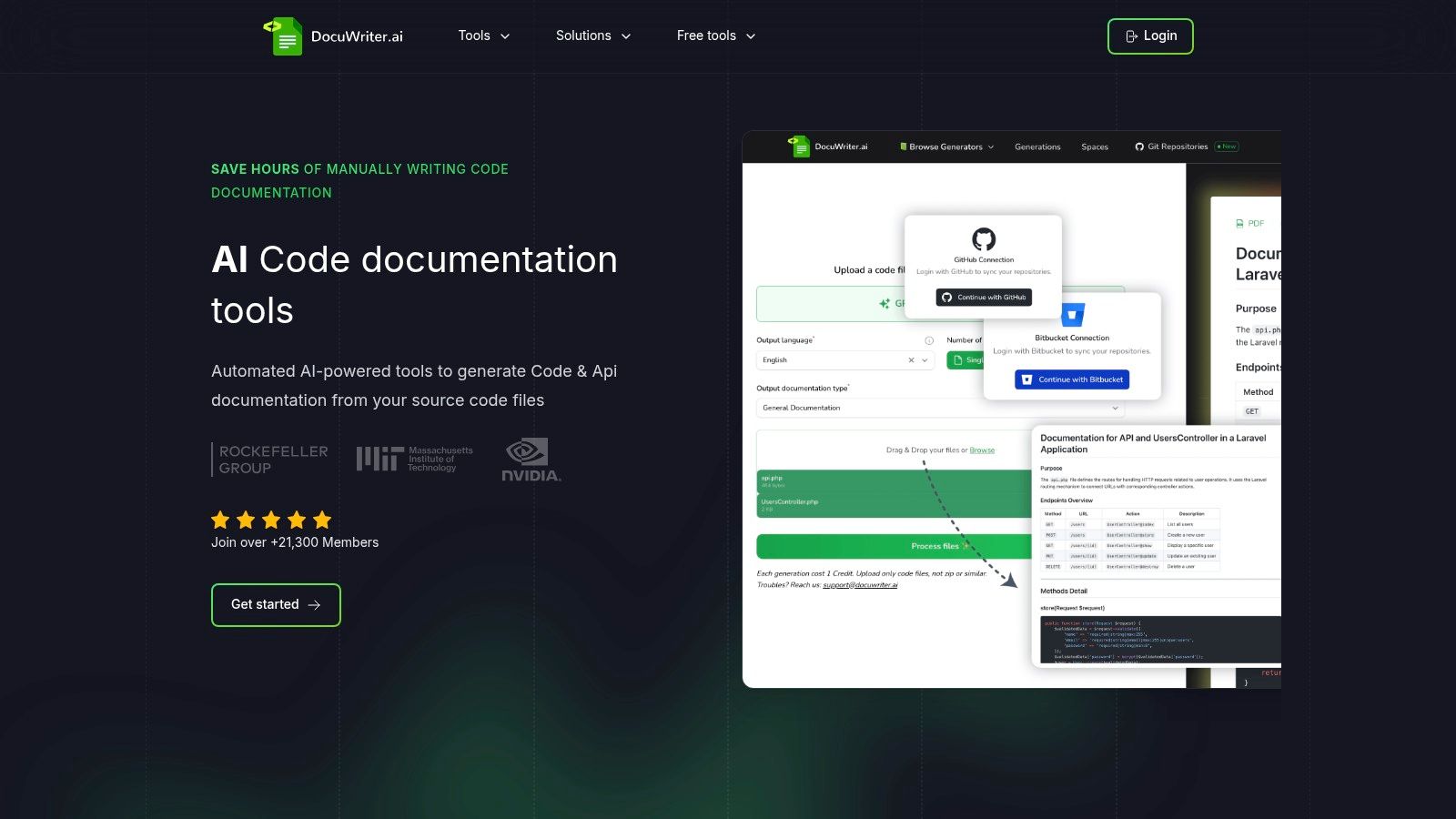
DocuWriter.ai’s core strength lies in its ability to automatically generate API documentation from code. This eliminates the tedious process of manually writing and updating documentation, freeing up valuable developer time. Beyond basic API documentation, DocuWriter.ai offers a range of features designed to elevate the entire documentation process. It can create UML diagrams, providing visual representations of code structure and relationships. The platform’s intelligent refactoring capabilities assist in improving code quality and maintainability, while multi-language code conversion simplifies working with diverse codebases. Even the often-dreaded task of generating code test suites is streamlined through AI assistance.
DocuWriter.ai caters to a broad spectrum of users, from individual freelancers working on small projects to large enterprises managing complex systems. Customizable workspaces facilitate organized documentation management, and seamless integrations with popular tools like Zapier and Git repositories enhance workflow efficiency. The availability of DocuWriter.ai through the VSCode marketplace further simplifies its adoption for developers. Learn more about DocuWriter.ai and its capabilities for auto-generating API documentation.
With flexible subscription plans starting at $19/month (billed yearly), DocuWriter.ai offers accessibility for various budgets. Professional, enterprise, and unlimited usage tiers provide scalability for growing teams and projects. Educational discounts are also available, making the platform an attractive option for students and educational institutions. The claimed time savings and documentation output by its user base (over 21,300 members, 87,500+ hours saved, and 33,600+ documents generated) underscore its potential value.
While DocuWriter.ai offers a powerful solution for automated API documentation, it is important to consider its limitations. The pricing, while flexible, might pose a barrier for very small teams or individual developers with extensive usage needs that exceed the Starter plan’s limits. While the AI-driven generation is highly efficient, manual review is still occasionally necessary, especially for complex code logic or nuanced functionalities, to guarantee absolute accuracy and clarity.
Comparing DocuWriter.ai with traditional manual documentation methods highlights its significant advantages in terms of speed, consistency, and scalability. Compared to other automated documentation tools, DocuWriter.ai distinguishes itself through its comprehensive feature set, which extends beyond basic documentation generation to encompass UML diagrams, code refactoring, and code conversion. This positions it as a more holistic solution for managing the entire code documentation lifecycle.
Implementing DocuWriter.ai is straightforward, typically involving signing up for an account, integrating it with your chosen code repository, and configuring the desired settings. Tips for maximizing its effectiveness include establishing clear documentation standards within your team, regularly reviewing the AI-generated output, and leveraging the platform’s collaboration features to ensure consistency across projects.
DocuWriter.ai earns its place as a top API documentation generator by addressing a critical pain point in the software development process. By automating a tedious yet essential task, it empowers developers to focus on building high-quality software while ensuring that their APIs are well-documented and easily accessible. While the pricing may need consideration for smaller teams and some manual review is still advised, the overall value proposition of DocuWriter.ai is undeniable, particularly for teams seeking to improve efficiency, maintainability, and collaboration throughout their development lifecycle.
OpenAPI Generator stands out as a leading choice among the best API documentation generators, offering a powerful and versatile solution for creating high-quality documentation, client SDKs, and server stubs. Its open-source nature, coupled with extensive language and framework support, makes it a valuable tool for individual developers and large engineering teams alike. Built around the OpenAPI Specification (formerly Swagger), it streamlines the process of documenting and interacting with APIs, fostering better communication and collaboration within development workflows. For those seeking a comprehensive and adaptable solution, OpenAPI Generator warrants serious consideration.
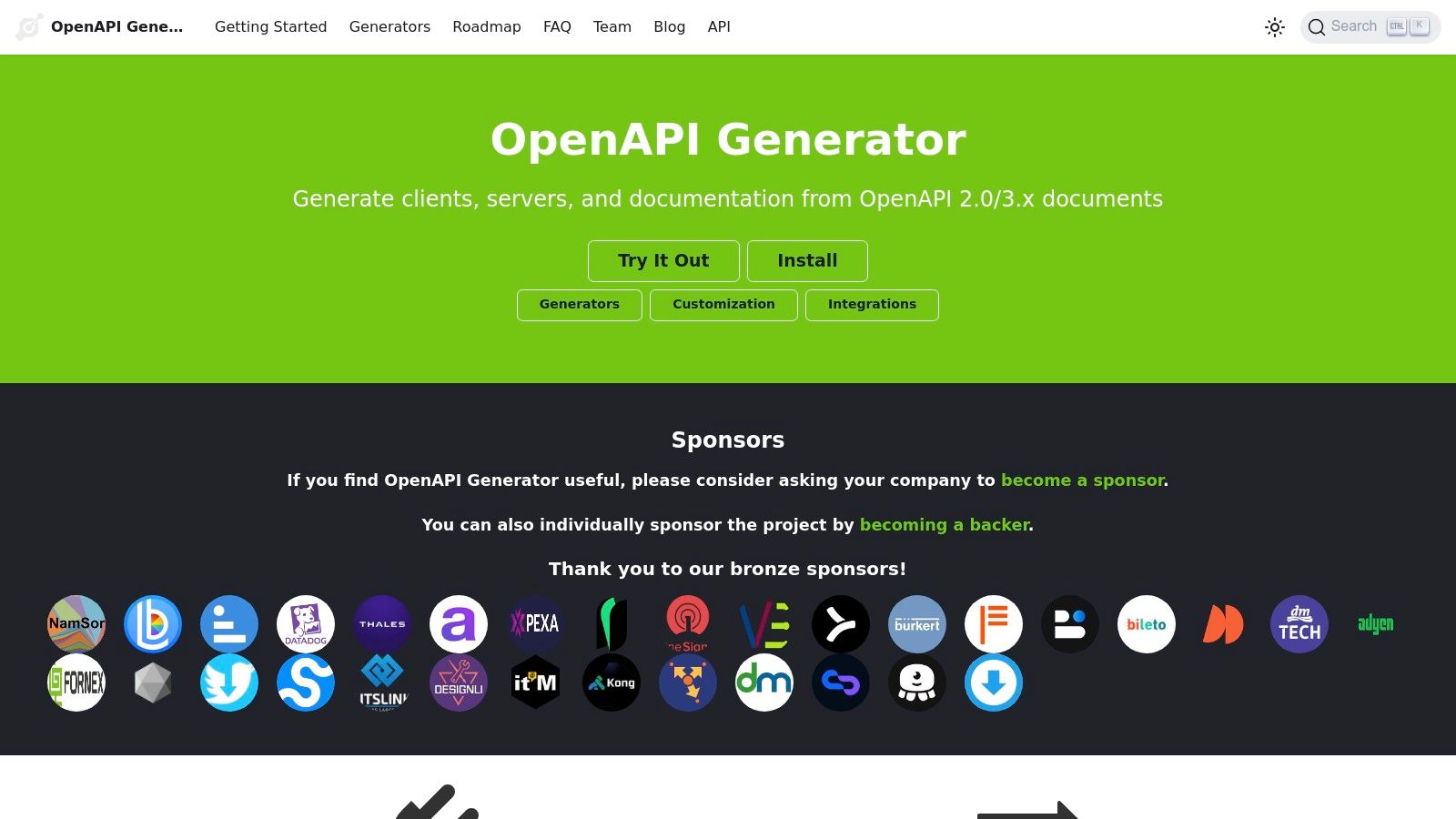
One of the primary strengths of OpenAPI Generator is its broad compatibility. Supporting over 50 programming languages and frameworks, including popular choices like Java, Python, JavaScript, Go, and C#, it caters to diverse development environments. This wide range of support enables teams to generate client SDKs and server stubs directly from their OpenAPI specification, saving significant development time and ensuring consistency across different platforms. Whether you’re building a web application, a mobile app, or a backend service, OpenAPI Generator likely supports the technologies you’re using.
OpenAPI Generator empowers developers to generate both static documentation and interactive API explorers. Static documentation provides a comprehensive overview of the API’s endpoints, parameters, and responses, serving as a valuable reference for developers integrating with the API. Interactive explorers, on the other hand, allow developers to experiment with the API directly, testing different requests and viewing the responses in real-time. This interactive element facilitates a deeper understanding of the API’s functionality and accelerates the integration process.
The tool offers significant flexibility through customizable templates and generators. This allows developers to tailor the generated output to their specific needs and preferences. For instance, you could customize the generated client SDKs to adhere to your organization’s coding style guidelines or modify the documentation templates to match your branding. This level of customization makes OpenAPI Generator adaptable to a wide range of projects and ensures that the generated output seamlessly integrates into existing workflows.
OpenAPI Generator is entirely free and open-source, providing developers with access to the source code and the ability to contribute to the project. This open-source model fosters a vibrant community of developers who actively contribute to the tool’s development and provide support to other users. The active community and regular updates ensure that the tool remains up-to-date with the latest OpenAPI specification changes and addresses any bugs or security vulnerabilities promptly. This makes it a reliable and trustworthy solution for long-term projects.
While OpenAPI Generator offers numerous advantages, there are some considerations to keep in mind. The tool does have a steeper learning curve for beginners, especially those unfamiliar with the OpenAPI specification. Understanding the intricacies of the OpenAPI specification is essential for effectively utilizing the tool’s capabilities. Furthermore, setting up OpenAPI Generator for advanced customizations can be complex, requiring a deeper understanding of the tool’s configuration options.
For those seeking a robust and adaptable API documentation generator, OpenAPI Generator offers a compelling solution. Its extensive language and framework support, coupled with its open-source nature and active community, makes it a valuable tool for developers of all skill levels. While there is a learning curve associated with the tool, the benefits it provides in terms of efficiency, consistency, and customization make it a worthwhile investment for any development team. You can find more information and download the tool at https://openapi-generator.tech/. Compared to other tools like Swagger Codegen (which it effectively replaces and extends), OpenAPI Generator’s wider language support and more robust templating engine make it a more powerful choice for complex projects. While simpler tools might suffice for smaller APIs, the comprehensive feature set of OpenAPI Generator shines when dealing with larger and more intricate API designs. It efficiently handles diverse needs, from generating client SDKs in less common languages to creating highly customized documentation that integrates seamlessly into existing developer portals. This versatility makes it the best api documentation generator for a broad range of users and project scales.
Swagger UI holds the crown as the most popular interactive API documentation generator, empowering developers to visualize and interact with APIs directly within their browser. Its strength lies in its ability to automatically generate aesthetically pleasing and interactive documentation from OpenAPI specifications (formerly Swagger specifications). This allows users to test API endpoints in real-time without needing any additional tools, simplifying the development process significantly. This ease of use and interactivity is a major reason why Swagger UI stands out among the best API documentation generators and has become the industry standard. Its position is further solidified by its open-source nature, making it accessible to a broad range of users, from individual developers to large enterprise teams.
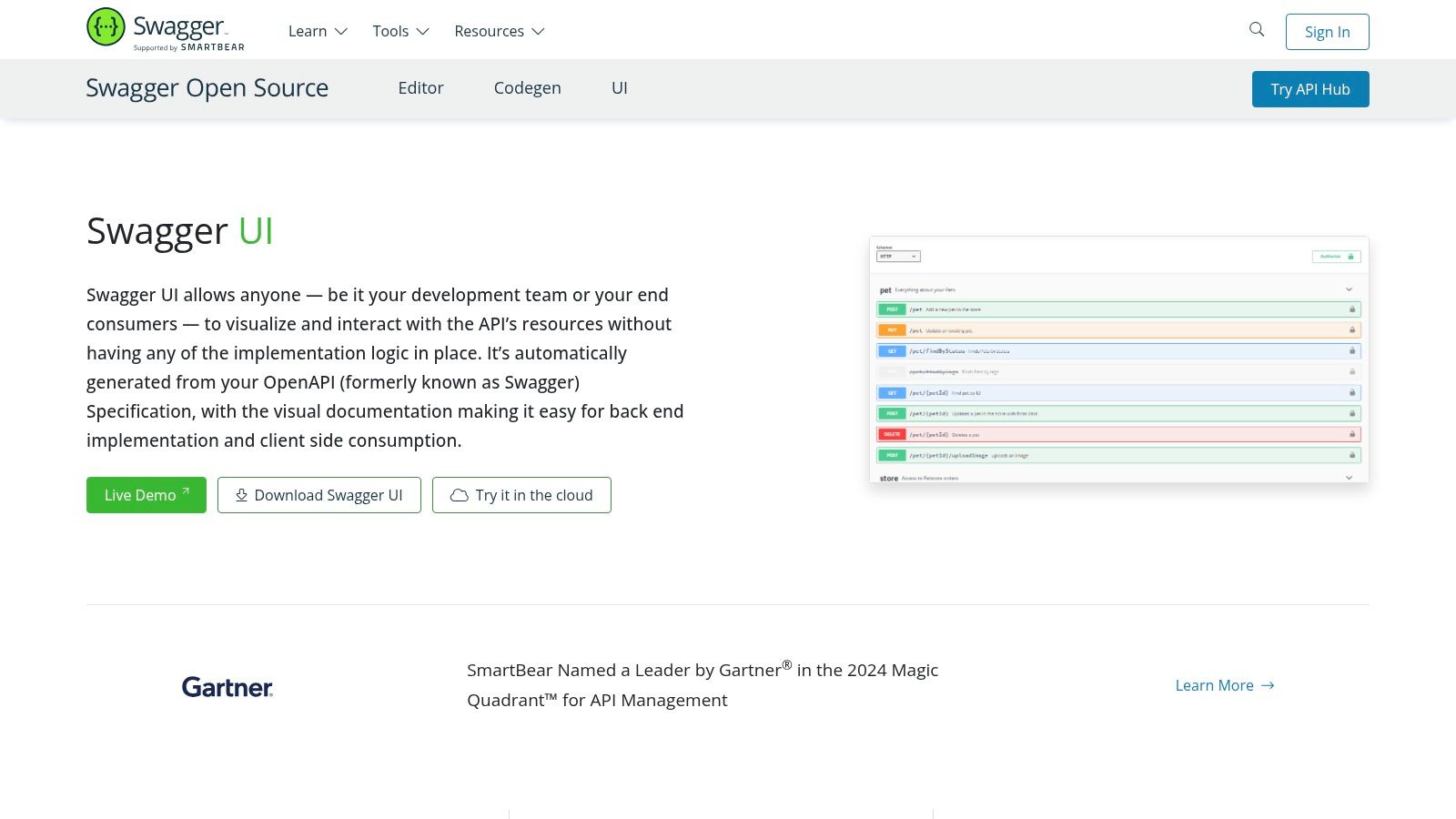
For software developers, Swagger UI drastically reduces the time spent on understanding and integrating with new APIs. Imagine a scenario where a front-end developer needs to integrate with a backend API developed by a separate team. Swagger UI acts as a bridge, providing a clear, interactive representation of the API’s functionality. The developer can explore available endpoints, understand required parameters, and even test API calls directly from the documentation, fostering seamless collaboration and faster integration times. This “try-it-out” functionality makes understanding the nuances of each endpoint far more intuitive than simply reading static documentation.
Furthermore, Swagger UI is a valuable asset for tech startups and small business owners who often rely on APIs for various functionalities like payment gateways, social media integrations, or mapping services. The interactive documentation allows them to quickly assess the capabilities of an API and determine its suitability for their specific needs. This self-service approach empowers non-technical users to gain a basic understanding of the API’s functionalities and make informed decisions without needing to consult a developer for every detail.
Key features that contribute to Swagger UI’s prominence include: an interactive API explorer with the aforementioned “try-it-out” functionality, enabling real-time API testing capabilities; responsive design ensuring optimal viewing on both mobile and desktop devices; support for OAuth2 and API key authentication mechanisms; and customizable themes and branding options to align the documentation with a company’s visual identity. This combination of features caters to a wide range of use cases and user preferences, solidifying Swagger UI’s position as a leading API documentation generator. You can learn more about Swagger UI and its role in building developer-friendly documentation.
While Swagger UI enjoys a prominent position in the API documentation landscape, it’s not without limitations. Customizing the appearance of the documentation beyond basic styling can require some technical expertise, potentially presenting a hurdle for users without coding experience. Additionally, the reliance on an OpenAPI specification is a prerequisite, meaning that developers need to first create this specification before leveraging Swagger UI. While the free version offers basic styling options, more advanced customization might require exploring commercial offerings within the Swagger ecosystem.
Despite these limitations, Swagger UI’s benefits often outweigh the drawbacks. Being free and open-source, it’s readily accessible. Its ease of integration with existing projects and its user-friendly interface for API testing make it a powerful tool for developers and technical teams. For any team seeking a robust, interactive, and widely adopted solution for their API documentation needs, Swagger UI remains a compelling choice, deserving its place among the best API documentation generators available. Its widespread adoption means extensive community support and readily available resources further contributing to its ease of use and accessibility. You can explore Swagger UI and its offerings on their official website: https://swagger.io/tools/swagger-ui/.
Postman has evolved from a simple API testing tool to a comprehensive API development platform, and a key part of that evolution is its robust API documentation generator. This functionality allows developers to seamlessly create, maintain, and publish high-quality documentation directly from their existing Postman collections. This tight integration between testing and documentation streamlines the development workflow and ensures consistency between the documented API specifications and its actual behavior. For teams seeking a unified platform for API development, Postman presents a compelling solution for generating and managing documentation. This makes Postman a strong contender for one of the best API documentation generators available.
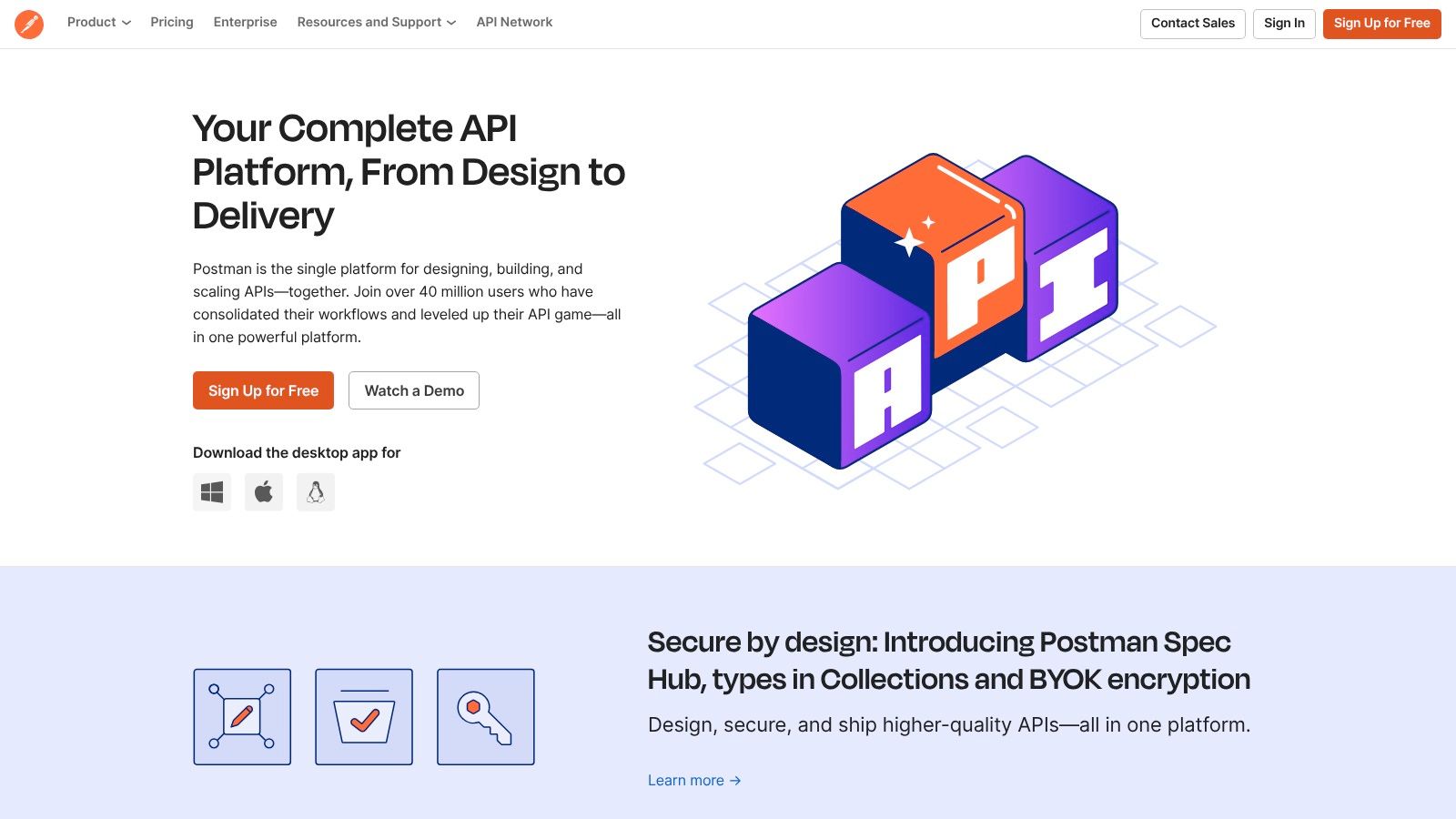
Postman’s documentation generation capabilities are particularly valuable for agile development teams. As API collections evolve during the development process, the associated documentation automatically updates, reflecting the latest changes. This real-time synchronization eliminates the tedious task of manually updating documentation, freeing up developers to focus on building and testing APIs. The platform also offers strong collaboration features, enabling teams to work together on API documentation in real-time. Multiple users can simultaneously edit and review documentation, facilitating seamless communication and ensuring everyone stays on the same page.
Postman excels in providing interactive examples and code snippets within the generated documentation. These examples allow developers to quickly understand how to use the API and integrate it into their applications. The code snippets are available in various programming languages, catering to a diverse range of developers. This feature significantly reduces the learning curve and speeds up the integration process. Furthermore, Postman’s version control and change tracking features allow teams to manage different versions of their API documentation and track changes over time. This is essential for maintaining a clear history of the API’s development and facilitating rollback to previous versions if necessary.
Beyond functionality, Postman offers customization options for presenting the documentation. Users can customize the domain and branding of their documentation to align with their organization’s identity. This allows for a professional and consistent presentation of API documentation to both internal and external stakeholders.
While Postman offers a free tier, many advanced features, including enhanced collaboration and customization options, are available only with a paid subscription. This can be a limiting factor for individuals or small teams with budget constraints. Additionally, Postman’s comprehensive feature set, while beneficial for complex projects, can feel overwhelming for those with simpler documentation needs. For generating documentation for a small, straightforward API, a lighter-weight tool might be more suitable. Finally, relying heavily on Postman for documentation creates vendor lock-in, making it difficult to switch to a different platform in the future.
Pricing: Postman offers a free tier with limited features. Paid plans start at $12/user/month and offer advanced collaboration, customization, and reporting features.
Technical Requirements: Postman is available as a desktop application for Windows, macOS, and Linux. It also offers a web version for browser-based access. No specific hardware requirements are listed, but a stable internet connection is necessary for accessing cloud-based features.
Implementation Tips:
Postman stands as a strong choice for best API documentation generator, especially for teams already invested in the Postman ecosystem. Its tight integration with API testing workflows, excellent collaboration features, and automatic synchronization make it a powerful tool for managing API documentation throughout the development lifecycle. However, the cost of advanced features and potential vendor lock-in are factors to consider when evaluating Postman against alternative solutions.
Insomnia is a robust API client and design platform that distinguishes itself through its developer-centric approach, offering a clean and intuitive interface for building, testing, and documenting APIs. It efficiently caters to both REST and GraphQL APIs, making it a versatile tool for a diverse range of projects. Its automated documentation generation feature directly leverages API specifications, significantly streamlining the process of creating and maintaining up-to-date documentation. This capability is particularly valuable for agile development workflows where API changes are frequent and documentation needs to keep pace. Its focus on collaborative features, including team workspaces and design sharing, positions it as a valuable asset for teams working together on API development. Insomnia earns its place among the best API documentation generators because it effectively combines design, testing, and documentation into a single, unified platform, enhancing developer productivity and promoting API quality.

One of Insomnia’s strengths lies in its excellent support for GraphQL, a query language for APIs. This is particularly important given the increasing adoption of GraphQL in modern web and mobile application development. Insomnia simplifies working with GraphQL schemas, allowing developers to easily explore and test queries and mutations. This is a key differentiator when compared to tools that primarily focus on REST APIs. For projects leveraging GraphQL, Insomnia provides a significant advantage in terms of development speed and efficiency. Furthermore, Insomnia’s performance remains commendable even when dealing with large and complex APIs, a crucial factor for enterprise-level applications. The active development and regular updates ensure that the tool remains current with the evolving API landscape and incorporates the latest best practices for API design and documentation.
Insomnia offers several pricing tiers, including a free tier with basic functionalities, a paid Individual plan for individual developers, and a Team plan designed for collaborative teams. The Team plan unlocks features like shared workspaces, team roles and permissions, and centralized billing. Specific pricing details are available on the Insomnia website. From a technical perspective, Insomnia is a cross-platform application available for Windows, macOS, and Linux. It’s a relatively lightweight application with minimal system requirements, making it easily accessible to developers on various platforms.
Setting up Insomnia is straightforward. After downloading and installing the application, users can import API specifications in various formats, such as OpenAPI (Swagger) and GraphQL schema files. The intuitive interface allows developers to quickly create and organize API requests, define environment variables for different environments (e.g., development, staging, production), and generate documentation automatically. One practical tip is to leverage Insomnia’s plugin ecosystem to extend its functionality and integrate with other tools in your development workflow. For instance, plugins are available for integrating with version control systems like Git, enhancing collaboration and streamlining the API development process.
Compared to other popular API documentation generators like Swagger UI and Postman, Insomnia stands out with its clean interface and strong focus on developer experience. While Swagger UI is a widely adopted solution for visualizing API documentation, Insomnia goes beyond visualization by integrating design, testing, and documentation into a single platform. Postman, while powerful, can sometimes feel overwhelming due to its extensive feature set. Insomnia offers a more streamlined approach, particularly beneficial for smaller teams or individual developers. However, it’s important to note that Insomnia’s community is smaller than that of some competitors, which can translate to fewer readily available resources and support options. Also, the free tier has limitations compared to the paid versions, restricting access to some advanced features.
Despite a few limitations, Insomnia is a strong contender for the title of “best API documentation generator” due to its focus on developer experience, robust GraphQL support, and efficient workflow. The clean and intuitive interface, coupled with automated documentation generation and collaboration features, makes it a valuable tool for both individual developers and teams. Its ability to handle large APIs with good performance further solidifies its position as a powerful and efficient API client and documentation platform. For developers seeking a modern and user-friendly tool that streamlines the entire API lifecycle, Insomnia (https://insomnia.rest/) is definitely worth considering.
Redoc earns its spot among the best API documentation generators due to its focus on delivering visually appealing and performant documentation, especially for large OpenAPI specifications. It excels in presenting complex API information clearly and efficiently, making it a strong contender for teams prioritizing readability and a polished presentation. Redoc prioritizes a sleek, modern design and smooth performance, even with extensive API documentation. It’s a particularly compelling choice for projects where the visual presentation of the API documentation is paramount, such as public-facing APIs or developer portals.
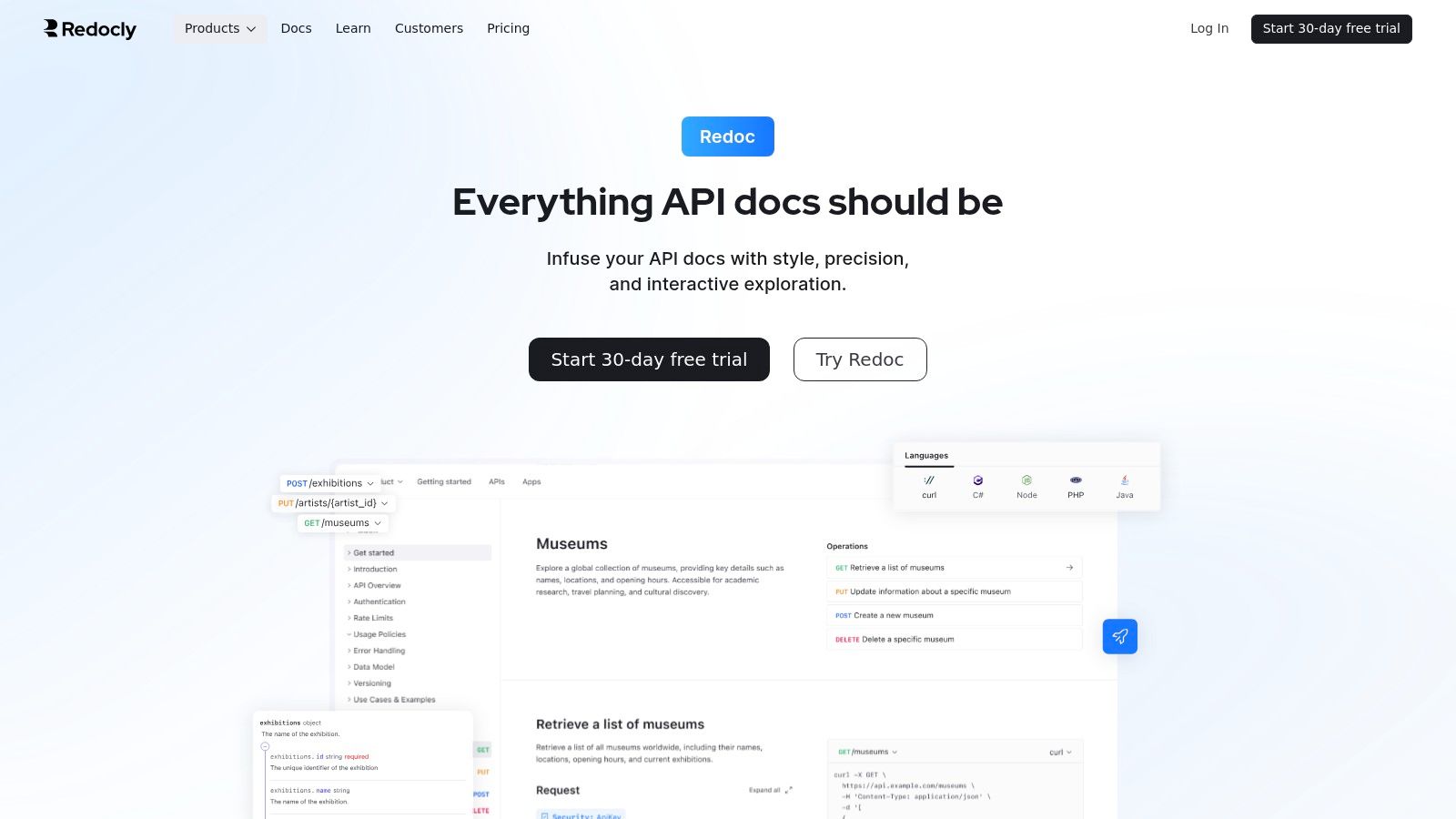
Redoc stands out with its three-panel design, offering navigation, content, and code examples side-by-side. This allows developers to quickly browse through different endpoints, understand their functionality, and see practical code examples without constant page reloads or jumps. The built-in search functionality with deep linking further enhances navigation, enabling developers to quickly find specific information within extensive documentation. This efficient navigation is crucial for complex APIs and significantly improves developer experience, making Redoc a compelling option for larger projects. When compared to tools like Swagger UI, which can sometimes feel cluttered with large APIs, Redoc’s streamlined design provides a breath of fresh air. While Swagger UI offers interactive testing capabilities, Redoc focuses on presenting clean, readable documentation, making it a preferred choice for projects where aesthetics and performance are paramount.
Redoc is built on open-source foundations, making it free to use and readily accessible. This contributes significantly to its popularity, especially among startups, small businesses, and individual developers. The availability of the source code allows for extensive customization and integration into existing workflows. While basic theming and styling options are available through configuration, more advanced customizations require coding skills. This open-source nature contrasts with some commercial API documentation generators that might offer more out-of-the-box features but come with licensing fees. This cost-effectiveness positions Redoc as an attractive solution for budget-conscious teams.
Implementing Redoc is straightforward. It leverages the OpenAPI specification (formerly Swagger), a standard format for describing RESTful APIs. This means if you already have an OpenAPI specification for your API, integrating Redoc is as simple as pointing it to the specification file. Redoc then parses this file and generates the documentation dynamically. Several integration options are available, including using Redoc’s standalone CLI tool, integrating it as a React component, or leveraging the pre-built Docker image. These diverse options provide flexibility for various development environments and deployment scenarios. For instance, a team utilizing a React-based developer portal can seamlessly integrate Redoc as a component. Alternatively, teams prioritizing rapid deployment can utilize the Docker image for a quick and consistent setup.
One area where Redoc falls short compared to some competitors like Swagger UI is the lack of built-in interactive testing capabilities. While Redoc focuses on presenting beautiful and performant documentation, it doesn’t allow developers to test API endpoints directly within the documentation interface. This necessitates using separate tools for testing, which can disrupt the developer workflow. Also, while Redoc offers customization through theming and styling, achieving significant design changes often requires delving into the codebase, which may be a hurdle for non-developers.
Despite these limitations, Redoc’s strengths lie in its excellent performance with large APIs, its beautiful and professional appearance, and its open-source nature, which facilitates easy integration and deployment. This makes it a highly valuable tool, particularly for presenting complex APIs in a digestible and aesthetically pleasing manner. Redoc is a strong choice for developers, tech startups, small businesses, and engineering teams looking for a best-in-class API documentation generator that prioritizes clear presentation and efficient navigation, especially when dealing with large and complex APIs. You can find more information and documentation on the official Redoc website: https://redocly.com/redoc/
GitBook is more than just a documentation platform; it’s a powerful content management system well-suited for creating aesthetically pleasing and highly organized API documentation. While not exclusively an API documentation generator like some specialized tools, its strengths lie in its collaborative features, robust version control, and focus on creating a seamless reading experience. This makes it a compelling choice for teams prioritizing maintainability, collaborative workflows, and a polished final product, securing its place amongst the best API documentation generators. It’s particularly attractive for projects where API documentation is part of a broader documentation strategy, integrating seamlessly with tutorials, guides, and other supporting content.
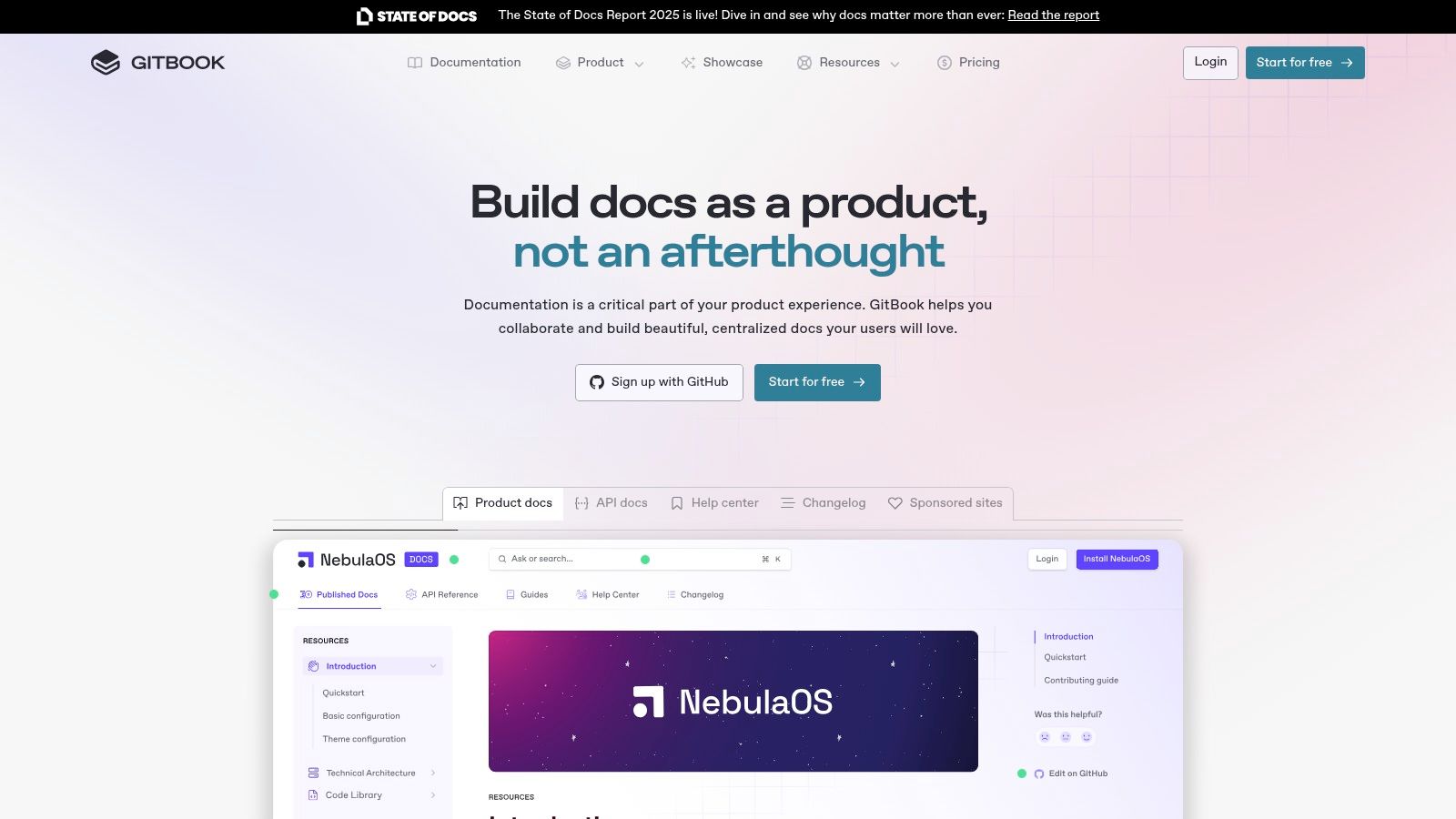
GitBook distinguishes itself with its WYSIWYG editor that supports Markdown, allowing both technical and non-technical users to contribute effectively. The integration with Git provides robust version control, facilitating collaborative editing, tracking changes, and simplifying rollbacks if necessary. This feature is invaluable for teams working on rapidly evolving APIs. Further enhancing collaboration are team review workflows, ensuring documentation quality and consistency.
One of GitBook’s key strengths is its focus on user experience. Advanced search and navigation features make it easy for developers to quickly find the information they need. The platform allows for custom domains and white-labeling, enabling seamless integration with your brand and presenting a professional image to your users. The resulting output is not only visually appealing but also well-optimized for SEO, improving discoverability for your API.
While GitBook offers many advantages, it’s crucial to consider potential drawbacks. Compared to specialized API documentation generators like Swagger UI or Postman, GitBook lacks built-in API testing capabilities. This means you’ll likely need to integrate with a separate testing tool, adding another layer to your workflow. Also, while it supports Markdown and provides a rich editor, it doesn’t offer API-specific features like automatic endpoint generation from code. This means more manual work, especially for large and complex APIs. Finally, while GitBook’s pricing model caters to various needs, it can become expensive for larger teams, potentially impacting budget considerations.
For instance, a small startup developing a REST API for its web application could leverage GitBook to build comprehensive documentation including not just API endpoints, but also tutorials, quick start guides, and SDK references, all within a unified and branded platform. This integrated approach streamlines the developer onboarding process and improves overall user satisfaction.
Comparing GitBook to a tool like Swagger UI highlights their different strengths. Swagger UI excels at generating interactive API documentation directly from code, offering built-in testing capabilities. GitBook, on the other hand, focuses on the broader documentation experience, providing superior content management, collaboration features, and a visually appealing output. Choosing between them depends on your specific priorities.
Setting up GitBook is straightforward. You can sign up for an account on their website (https://www.gitbook.com/) and choose a plan that fits your needs. They offer a free tier for individual users and paid plans for teams and businesses with varying features and limitations. After setting up your account, you can create a new space for your API documentation, import existing Markdown files, or start writing from scratch. Git integration is seamless, allowing you to connect your repository and manage your documentation via version control.
In conclusion, GitBook offers a robust and comprehensive platform for creating high-quality API documentation. Its strengths lie in its collaboration features, excellent editing experience, and beautifully rendered output. While it may not offer the API-specific features of some dedicated tools, its focus on content management and user experience makes it a powerful choice for teams prioritizing maintainability, collaboration, and a polished, professional presentation for their best API documentation generator needs. Its versatility makes it suitable for a wide range of users, from individual developers to large engineering teams, provided its pricing model aligns with their budget. If you are looking for a best api documentation generator that prioritizes a seamless editing and publishing experience with strong collaborative features, GitBook is definitely worth considering.
Slate stands as a prominent contender in the realm of API documentation generators, earning its place on this list due to its open-source nature, robust customization options, and focus on creating clean, easily navigable documentation. It caters specifically to the needs of developers seeking a straightforward yet powerful solution for presenting their APIs. Utilizing a static site generation approach, Slate prioritizes speed and simplicity, allowing developers to focus on content creation rather than complex setup and maintenance. This makes it a particularly appealing option for startups, small businesses, and individual developers seeking a free and effective documentation solution.
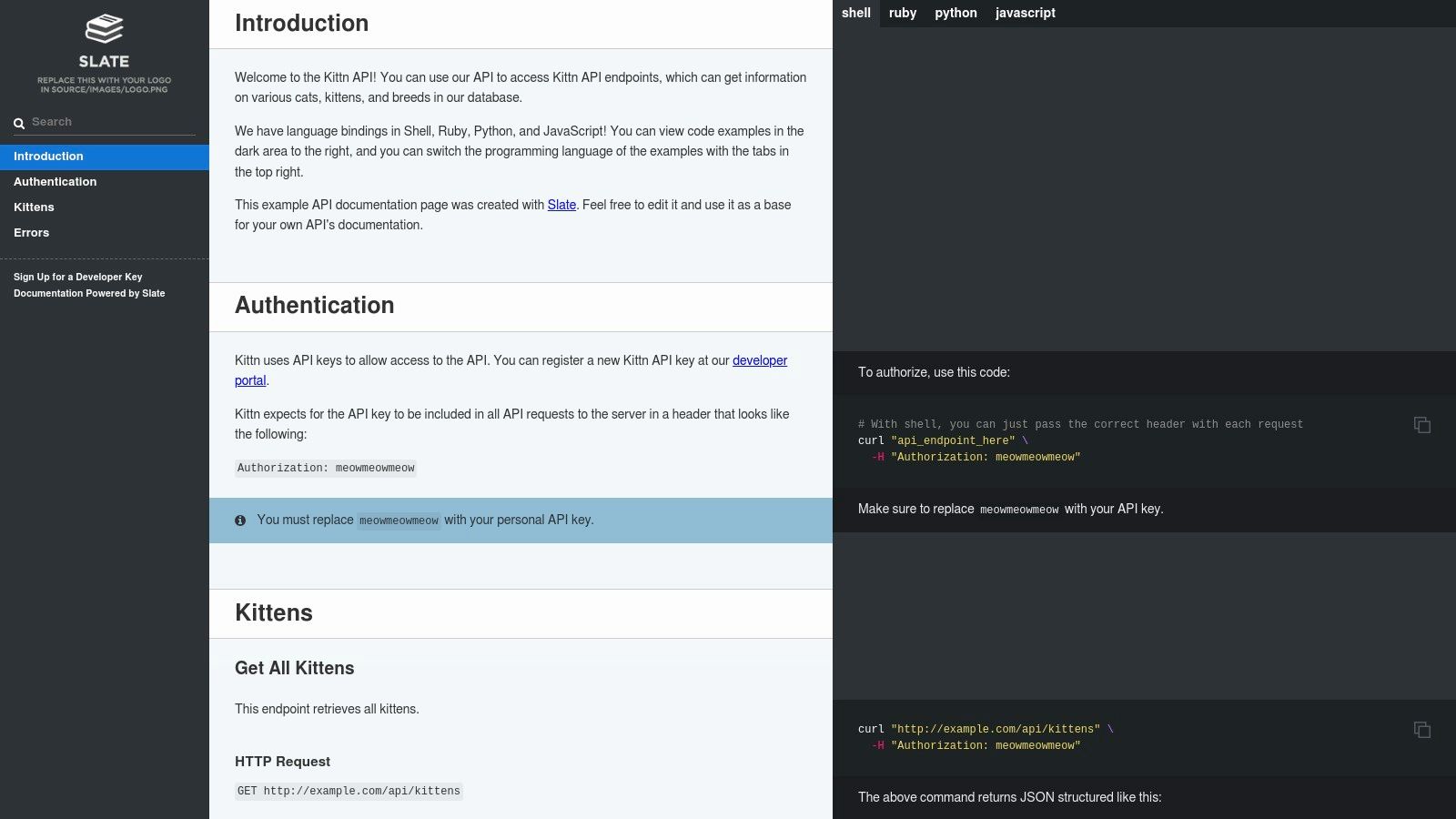
One of Slate’s key strengths lies in its three-column layout. This structure provides a clear separation between navigation, content, and code examples, enhancing readability and facilitating quick access to relevant information. This is especially crucial for complex APIs where developers need to easily find specific endpoints, parameters, and usage examples. The left-hand navigation pane provides a hierarchical view of the API structure, while the main content area explains functionalities and the right-hand pane displays illustrative code snippets. This intuitive organization makes it significantly easier for developers to understand and integrate with the documented API.
Slate’s reliance on Markdown for content creation further simplifies the documentation process. Markdown’s ease of use and readability makes it a popular choice amongst developers, allowing them to write documentation using a familiar syntax. Combined with Slate’s built-in support for syntax highlighting across multiple programming languages, this ensures that code examples are presented clearly and accurately. This reduces the learning curve associated with adopting a new documentation tool and allows developers to quickly generate professional-looking documentation.
Being a static site generator, Slate produces websites that are incredibly fast to load. This is a significant advantage over dynamically generated documentation, particularly for users with limited bandwidth or those accessing the documentation from mobile devices. The static nature of the site also simplifies deployment, allowing developers to host their documentation on a wide range of platforms, from GitHub Pages to custom servers. Furthermore, the responsive design ensures that the documentation remains accessible and user-friendly across different screen sizes and devices, catering to the increasingly mobile-centric developer landscape.
As an open-source project, Slate is completely free to use and benefits from contributions and support from a vibrant developer community. This translates to regular updates, bug fixes, and a wealth of readily available resources. Furthermore, the highly customizable nature of Slate allows developers to tailor the look and feel of their documentation to match their brand or project requirements. While requiring Ruby for more advanced customization, the core functionality remains accessible even without deep Ruby knowledge. This makes it suitable for developers with varying levels of technical expertise.
However, it’s essential to acknowledge Slate’s limitations. The initial setup requires a certain level of technical proficiency, which may pose a barrier for non-technical users. Unlike some other API documentation generators, Slate doesn’t offer interactive API testing capabilities. Developers need to rely on external tools for testing their APIs. Content management remains manual, requiring developers to update the Markdown files directly. While this offers flexibility, it also means that there’s no built-in content management system or collaborative editing features.
Compared to cloud-based solutions offering automated documentation generation and interactive features, Slate demands more hands-on involvement. Tools like Swagger UI provide interactive API exploration and testing, features absent in Slate. However, Slate’s simplicity and focus on static site generation make it a strong alternative for projects prioritizing speed, customization, and cost-effectiveness. If you’re seeking a free, highly customizable, and performant best api documentation generator, and are comfortable with a bit of technical setup, Slate is undoubtedly a worthy choice. For those requiring interactive features or automated content management, exploring alternative solutions might be more beneficial. You can find more information and documentation on the official Slate website: https://slatedocs.github.io/slate/
Finding the best API documentation generator can feel overwhelming with so many options available. This article explored eight leading tools, ranging from AI-powered solutions like DocuWriter.ai to established favorites like Swagger UI and OpenAPI Generator. Each offers unique strengths, catering to various project scales, technical skill levels, and desired levels of customization. Key takeaways include the importance of considering factors like automation capabilities, supported output formats (like OpenAPI specifications), integration with existing workflows, and ease of use. Remember, effective documentation is crucial for API adoption and developer experience.
Selecting the appropriate tool requires careful consideration of your specific circumstances. For instance, a small startup with a rapidly evolving API might prioritize a flexible, easy-to-use tool like Postman or Insomnia. Larger enterprises with complex APIs may benefit from the robust features and customization options offered by Redoc or GitBook. Similarly, when faced with different challenges, choosing the correct solution is paramount. Just as understanding the difference between a fire blanket vs fire extinguisher is critical for addressing specific fire hazards – as highlighted in Fire Blanket vs Fire Extinguisher: Which Is Safer for You? from fireblanket.com – choosing the right API documentation generator is crucial for effective communication with your developer audience. Consider the size and complexity of your API, your team’s familiarity with specific tools, and your budget when making your decision.
Implementing your chosen tool effectively also requires thoughtful planning. Integrate the documentation generation process into your development workflow to ensure consistency and avoid documentation becoming outdated. Establish clear guidelines for your team regarding documentation style and content. Regularly review and update your documentation to reflect API changes and incorporate user feedback.
By taking these factors into account and carefully evaluating the options presented, you can find the best API documentation generator to streamline your workflow and empower developers. Streamline your API documentation process and unlock the potential of AI-powered automation with DocuWriter.ai. Its intuitive interface and powerful features make creating and maintaining world-class API documentation effortless, freeing your team to focus on building exceptional products.